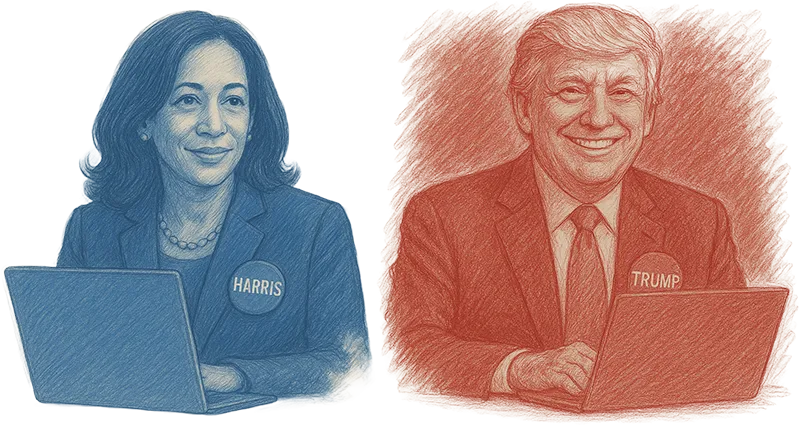2024 Election: Reshaping Business Education
How the Trump vs Harris presidential campaign demonstrates the exact Excel pivot table analysis, demographic filtering, and CSV file manipulation techniques that students master in MISsimulation - providing cutting-edge data analytics training for modern business education.

The New Campaign Playbook
The 2024 U.S. presidential election between Donald Trump and Kamala Harris has done more than determine America's political future—it has provided a masterclass in data-driven decision making that's reshaping how we teach business computing and information systems.
As campaigns increasingly operate like sophisticated businesses, educational institutions are finding innovative ways to prepare students for this data-centric world.
From Campaign Strategy to Simulation Practice
AI-Powered Campaign Analytics
Both campaigns deployed sophisticated AI tools for audience analysis and content optimization. These technologies mirror business intelligence systems used across industries for customer analytics and market segmentation.
Social Media Influence Analytics
2024 Campaign Method: Students use Microblogging datasets to identify influencers (users with 50+ followers), analyze follower networks using Excel pivot tables. Track influential users through Microblogging Candidates' Followers dataset updates, replicating 2024 campaigns' focus on social media amplification and viral content strategies.
Micro-Influencer Engagement
The Harris campaign's collaboration with micro-influencers across social platforms demonstrates precision targeting techniques that businesses use for reaching niche customer segments.
Targeted Promoted Content
Harris Method Implementation: Students target influential users with promoted posts, analyze reshare patterns through Microblogging data. Use demographic filtering to identify micro-influencers in specific age/income segments, then deploy targeted social media campaigns that mirror Harris's precision micro-influencer strategy.
Real-Time Strategy Adaptation
Both campaigns adapted strategies in real-time based on constituent feedback, showcasing the agile business practices that modern organizations must master in dynamic markets.
Viral Content Optimization
Turn-by-Turn Adaptation: Students analyze follower growth through Microblogging Candidates' Followers dataset updates, adjust content strategy based on reshare patterns. Upload revised campaign strategies targeting users with high engagement rates, optimizing for viral amplification like 2024 campaigns.
Targeted Messaging Systems
The Trump campaign's mastery of targeted messaging through established channels demonstrates the kind of precise audience segmentation that drives business success.
Multi-Platform Campaign Distribution
Trump's Messaging Strategy: Students use MISsimulation's 8 datasets (Voter Registration, Credit Card Applications, House Mortgage, Independent Survey, Gun Purchases, Vehicle Ownership, Microblogging Users, and Survey Results) to create comprehensive voter profiles for targeted messaging across multiple campaign channels.
2024 Campaign Social Media Analytics in MISsimulation
Social Media Campaign Workflow
Use Microblogging Users dataset to identify influencers with 50+ followers. Create pivot tables analyzing follower networks and engagement patterns across demographic segments.
Target influential users with promoted posts, track reshare patterns through Microblogging data. Analyze which content types generate highest engagement among different voter segments.
Monitor follower growth through Microblogging Candidates' Followers dataset updates. Adjust targeting strategy based on viral amplification metrics and engagement data.
Recommended 7-Turn Strategy
- Download Microblogging Users dataset + Voter Registration
- Identify key influencers and follower networks
- Create demographic profiles of social media users
- Deploy promoted posts targeting micro-influencers
- Track reshare patterns and viral amplification
- Adjust content strategy based on engagement metrics
- Integrate social media insights with traditional voter data
- Optimize campaign budget across digital and traditional channels
- Measure overall campaign ROI including social amplification
Success Metrics & Learning Outcomes
Measurable Campaign Outcomes
- Viral Amplification Rate: Track content reshares and follower growth through social media campaigns
- Influencer Engagement: Measure micro-influencer activation and content distribution effectiveness
- Multi-Platform ROI: Compare traditional voter targeting vs. social media amplification costs
- Demographic Precision: Accuracy of social media voter segmentation and targeting
Skills for the Digital Economy
- Social media influence analytics and network mapping
- Viral content strategy and engagement optimization
- Multi-platform campaign budget distribution
- Real-time analytics and competitive intelligence analysis
- Digital strategy integration with traditional voter outreach
Transforming Business Education
Skills for the Digital Economy
- Data literacy and digital strategy fundamentals
- Real-time analytics and decision making
- Multi-platform campaign management
- Competitive intelligence analysis
- Strategic resource optimization
Future-Ready Learning
The 2024 election demonstrates that data literacy and digital strategy are no longer optional skills—they're fundamental to modern campaign and business success.
MISsimulation bridges the gap between political strategy and business strategy, preparing students for a data-driven professional landscape where these skills increasingly overlap.
Research Sources
- Technology Review (2024) - "Three Technology Trends Shaping the 2024 Elections"
- The Verge (2024) - "Perplexity AI Election Voting Information Hub - US Presidential Election 2024"
- Politico (2024) - "What AI Is Doing to Campaigns"
Experience 2024 Campaign Analytics
Master the same cutting-edge techniques used in the Trump vs Harris campaign through hands-on simulation and real-world application.